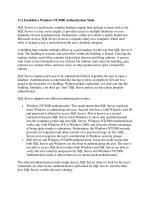Authentication
Bạn đang xem bản rút gọn của tài liệu. Xem và tải ngay bản đầy đủ của tài liệu tại đây (707.18 KB, 38 trang )
LESSON 7
AUTHENTICATION
USER MANAGEMENT
Authentication
Xác nhận người sử dụng
Authorization
Kiểm soát quyền của người sử dụng
Accounting
Theo dõi thống kê hành động
WHAT IS AUTHENTICATION?
Identification – Dấu hiệu, công cụ nhận dạng,
nhận biết.
Quá trình kiểm tra dấu hiệu nhận biết gọi là xác
thực Authentication.
3 Categories:
What you know
What you have
Who you are
WHAT YOU KNOW
Password
Passphrase
PIN (Personal Identification Number)
Challenge/Response
PASSWORD
Ưu điểm
Đơn giản
Dễ sử dụng và quản lý
Nhược điểm
Phải nhớ
Không an toàn
ĐỘ AN TOÀN CỦA PASSWORD
Alphabet
Recommend
Độ dài không nhỏ hơn 8
Tổ hợp chữ hoa, chữ thường, số, các ký tự đặc biệt
Các phương pháp tấn công
Từ điển
Lựa chọn
Vét cạn
WHAT YOU HAVE
One time password
Keys Exchange
Digital authentication
physical devices to aid authentication
Common examples:
eToken
smart cards
RFID
ONE TIME PASSWORD
Pseudorandom Generator
Session time
Synchronization
ETOKEN
Can be implemented on a USB key fob or a
smart card
Data physically protected on the device
itself
On the client side, the token is accessed via
password
Successful clientside authentication with
the password invokes the token to generate
a stored or generated passcode, which is
sent to the serverside for authentication.
ETOKEN
May store credentials
such as passwords,
digital signatures and
certificates, and
private keys
Can offer onboard
authentication and
digital signing
SMART CARDS
Size of a credit card
Usually an embedded microprocessor with
computational and storage capabilities
Programmable platforms:
C/C++
Visual Basic
Java
.Net (beta)
SMART CARDS CONT’D
Contact vs. contactless
Memory vs. microprocessor
RFID
RFID Radio Frequency IDentification
Integrated circuit(s) with an antenna that
can respond to an RF signal with identity
information
No power supply necessary—IC uses the
RF signal to power itself
Susceptible to replay attacks and theft
Examples:
Smart Tag, EZPass
Garage parking permits
RFID
13.56Mhz read/write
support
May communicate with a
variety of transponders
(ISO15693, ISO14443
Type A & B, TagIt, Icode,
etc.)
Reader is controlled via
PCMCIA interface using
an ASCII protocol
WHO YOU ARE
Biometric authentication
Use of a biometric reading to confirm that a person is
who he/she claims to be
Biometric reading
A recording of some physical or behavioral attribute of
a person









